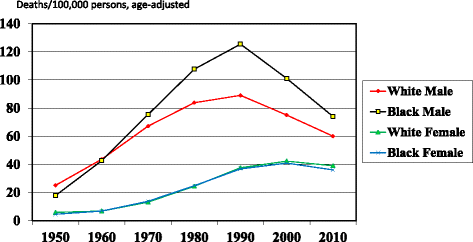Racial and ethnic disparities in smoking prevalence in Israel and the United States: progress to date and prospects for the future
- PMID: 28969689
- PMCID: PMC5625817
- DOI: 10.1186/s13584-017-0177-9
Racial and ethnic disparities in smoking prevalence in Israel and the United States: progress to date and prospects for the future
Abstract
An article in this journal in 2016 demonstrated that smoking prevalence among Arab men in Israel is greater than among their Jewish counterparts born in Israel, while the reverse is true among Arab and Jewish Israeli women. This is reflected in lung cancer mortality rates. In the U.S., smoking prevalence in the mid-1960s was 20% higher in African American men than in white men, but has since decreased in both groups, and smoking prevalence in the two groups is now nearly identical. The black-white disparity in lung cancer mortality rates has been reduced by more than half as compared to its zenith in the early 1990s. The strategies employed to achieve these gains will continue to be important going forward, and successful strategies employed in Israel in addressing smoking in the male Arab population will be of increasing interest in the U.S. as its Arab population increases.
Keywords: Disparities; Lung cancer; Smoking; Smoking cessation; Tobacco.
Conflict of interest statement
Author information
The author is Professor Emeritus of Community Health and Preventive Medicine at Morehouse School of Medicine, Atlanta GA, USA, and Extraordinary Professor of Community Health at Stellenbosch University, Cape Town, South Africa. He is Immediate Past President of the American College of Preventive Medicine.
Ethics approval and consent to participate
Not applicable: this commentary is not a research report and no human subjects are involved.
Consent for publication
Not applicable: this manuscript includes no data on any individual person.
Competing interests
The author declare that there are no competing interests.
Publisher’s Note
Springer Nature remains neutral with regard to jurisdictional claims in published maps and institutional affiliations.
Figures
Comment on
-
Social characteristics associated with disparities in smoking rates in Israel.Isr J Health Policy Res. 2016 Dec 1;5:36. doi: 10.1186/s13584-016-0095-2. eCollection 2016. Isr J Health Policy Res. 2016. PMID: 27957321 Free PMC article.
References
-
- OECD (2012) Tackling Inequalities in Health and Health Care in Israel in OECD Reviews of Health Care Quality: Israel 2012: Raising Standards. OECD Publishing. doi:http://dx.doi.org/10.1787/9789264029941-7-en. - DOI
-
- Blumenthal DS. Reducing and Eliminating Health Disparities through Prevention and Public Health. Journal of the Georgia Public Health Association. 2016;6(1):3–6.
-
- Terry L: Smoking and Health: Report of the Advisory Committee to the Surgeon General. https://profiles.nlm.nih.gov/ps/retrieve/Narrative/NN/p-nid/60. Accessed September 19, 2017.
-
- Data from National Center for Health Statistics. Health, United States, 2015: With Special Feature on Racial and Ethnic Health Disparities. Hyattsville, MD 2016. https://www.cdc.gov/nchs/data/hus/hus15.pdf. - PubMed
Publication types
MeSH terms
Grants and funding
LinkOut - more resources
Full Text Sources
Other Literature Sources



